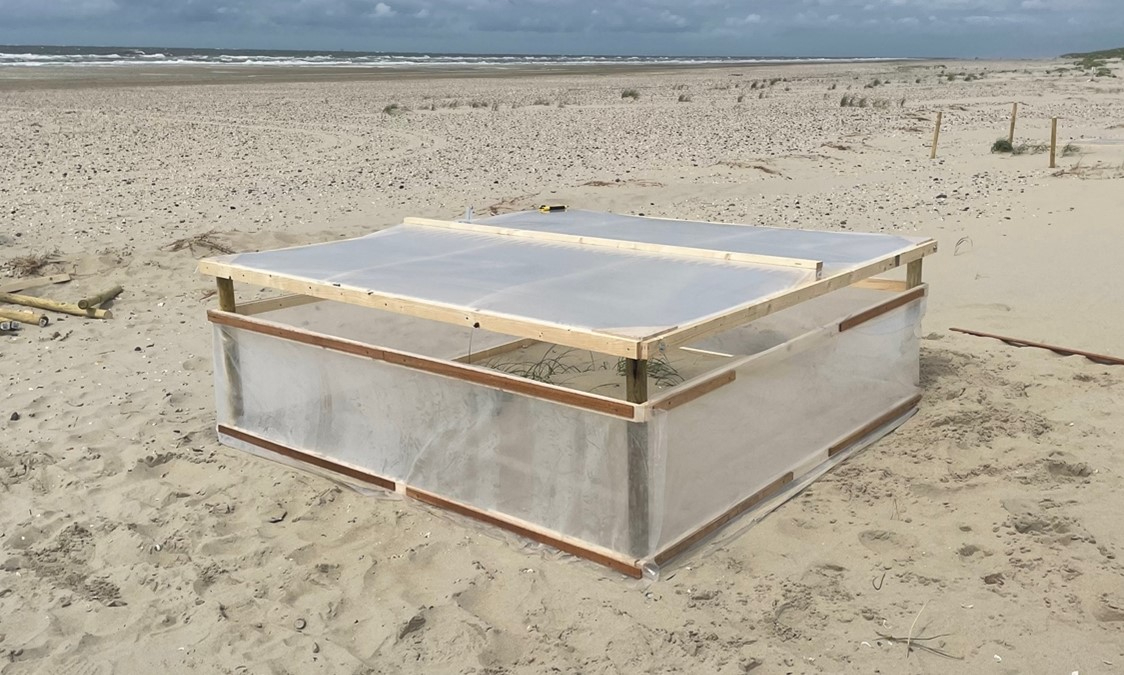Biestarwegras en helmgras spelen een grote rol bij de ontwikkeling van het duinsysteem. Over het algemeen kunnen deze soorten goed tegen droogte en hitte, maar ze groeien beter als ze regelmatig regen (dus zoetwater) krijgen. Wij verwachten dat de planten in de duinen een grote rol spelen bij het vasthouden van water in de bodem en dus de gevolgen van een hittegolf zouden kunnen verzachten. We willen in ons experiment testen 1) wat het effect van een hittegolf is op biestarwegras planten van verschillende groottes, 2) wat het effect van een hittegolf is op de vestiging en groei van aangeplant helmgras en 3) hoe lokale omstandigheden, zoals aan- of afwezigheid van biestarwegras, de vestiging en groei van dit helmgras beïnvloeden.
Om dit te onderzoeken hebben we een soort kassen op het strand geplaatst, waarmee we op een kleine schaal een hittegolf kunnen nabootsen. Meer dan 30 van deze kassen zijn over de verschillende biestarwe of helmgras planten gezet. Deze planten zullen worden vergeleken met planten die buiten de kassen staan om de verschillen in overleving en groei goed te kunnen volgen. De temperatuur, lichtintensiteit en bodemcondities worden gevolgd en vergeleken tussen de verschillende behandelingen.

At the beach of Schiermonnikoog at ‘paal 10’ we are researching the effect of heatwaves on the survival and growth of dune grasses. Climate change may have large consequences for the world. However, it is hard to predict how the climate is going to change and how different species and ecosystems will respond to these changes. Because of global change, sea level and temperature are expected to rise, but also an increase of extreme climatic events, such as heatwaves, is expected. We want to know what the effect is of heatwaves on the growth and survival of two dune grass species: sand couch (Elytrigia juncea) and marram grass (Ammophila arenaria).
Sand couch and marram grass play a vital role in the development of dune systems. These species are generally very well adapted to living in dry and warm conditions. However, they grow better when they get sufficient rain (i.e. fresh water). We expect that plants in the dunes play an important role in retention of water in the soil. Therefore, existing vegetation could mitigate the effects of heatwaves. What we are researching in our experiment is 1) what the effect is of heatwaves on sand couch plants of different sizes, 2) what the effect is of heatwaves on establishment and growth of newly planted marram grasses and 3) how local conditions, such as presence of sand couch plants, affect the establishment and growth of marram grass.
To test this, we build small greenhouses on the beach with which we can simulate a heatwave on a small scale. Over 30 of these greenhouses are placed on top of sand couch and/or marram grass plants. The survival and growth of these plants will be compared with plants outside the greenhouses. The temperature, light intensity and soil conditions are monitored over time to see differences between the treatments.
Contact: carlijn.lammers@nioz.nl and/or paul.berghuis@nioz.nl